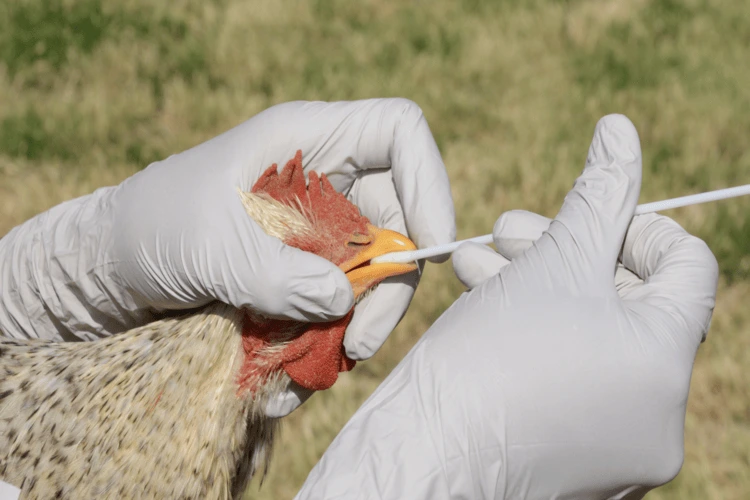
New test for bird flu provides results before the virus spreads
By
In March, the UK’s chief veterinary officer confirmed that the world’s first known case of avian influenza (H5N1) infecting a sheep had occurred on a farm in Yorkshire. While this isn’t the first instance of bird flu in livestock – the disease has spread so rapidly through dairy farms in California that US farmers are calling it ‘Covid for cows’ – this latest case highlights the growing threat the virus poses to a wider range of species, including humans.
Related reads:
The current major outbreak of bird flu has been ongoing since 2020, when a new strain of the H5N1 virus – well adapted to wild bird species – spread across Europe, Africa, the Middle East and Asia. To date, more than 50 million domesticated birds have been culled across Europe in an attempt to contain the virus. In the USA alone, a similar number of chickens were culled between December 2024 and February 2025, causing egg prices to skyrocket.
In many cases, bird flu spreads through a flock before the first case is detected. A new aerosol test that can detect airborne bird flu in under five minutes could help change that.
According to Rajan Chakrabarty, professor of environmental and chemical engineering at Washington University in Missouri, USA, farmers commonly rely on swabs and blood tests to detect bird flu – tests that, once sent to a lab, can take between 12 and 72 hours to return a result. ‘In that time, the number of cases can increase exponentially.’

At the Chakrabarty Lab, researchers have been developing a new biosensor, the first of its kind, that can quickly detect H5N1 concentration levels on a farm while preserving a sample of the microbes for further analysis (many still want to retain standard PCR testing, Chakrabarty explains).
The sensor is integrated into a portable air-sampling device, about the size of a standard printer, that can be positioned at the air vents of any barn housing poultry or cattle. The device uses a ‘wet cyclone bio-aerosol sampler’ to mix pathogen-laden air with a liquid before automatically pumping the liquid to the biosensor. Despite the complex science behind it, Chakrabarty insists the instrument is user-friendly and can be operated by anyone. ‘And the sensors cost less than US$1, so it’s cheap to run.’ Another benefit of the device is its adaptability – it can also be configured to detect other dangerous airborne pathogens, including other strains of influenza (such as H1N1), Covid-19 and bacteria such as E. coli.
Chakrabarty explains that the motivation behind the research came in the form of a report, published in the New England Journal of Medicine last year, on a case of a farm worker in Texas who contracted a highly virulent strain of bird flu from cattle.
‘Airborne viruses travel much more quickly and easily compared to waterborne ones. Usually, viruses don’t spread through the air until they’ve evolved to become better at infecting hosts, so seeing bird flu reach that stage – being able to spread from cows to humans – so quickly was a huge red flag for us. We did some calculations based on that first case and they suggested that within a year, we’d likely see many more cases. And that’s exactly what’s happening now – we’re seeing multiple instances of this virus spreading through the air between mammals.’
At the moment, the increasing number of cases of bird flu in livestock doesn’t pose a significant risk to people – cases have remained rare. But experts warn that as H5N1 continues to evolve, it could adapt to transmit from human to human. Many historic flu pandemics, including the 1918 Spanish flu, estimated to have caused 50 million deaths, were avian in origin. ‘This is why we need to act fast,’ says Chakrabarty. ‘To prevent it from spreading further.’
To date, more than 50 million domesticated birds have been culled across Europe in an attempt to contain the virus. In the USA alone, a similar number of chickens were culled between December 2024 and February 2025, causing egg prices to skyrocket.
In many cases, bird flu spreads through a flock before the first case is detected. A new aerosol test that can detect airborne bird flu in under five minutes could help change that.
According to Rajan Chakrabarty, professor of environmental and chemical engineering at Washington University in Missouri, USA, farmers commonly rely on swabs and blood tests to detect bird flu – tests that, once sent to a lab, can take between 12 and 72 hours to return a result. ‘In that time, the number of cases can increase exponentially.’

At the Chakrabarty Lab, researchers have been developing a new biosensor, the first of its kind, that can quickly detect H5N1 concentration levels on a farm while preserving a sample of the microbes for further analysis (many still want to retain standard PCR testing, Chakrabarty explains).
The sensor is integrated into a portable air-sampling device, about the size of a standard printer, that can be positioned at the air vents of any barn housing poultry or cattle. The device uses a ‘wet cyclone bio-aerosol sampler’ to mix pathogen-laden air with a liquid before automatically pumping the liquid to the biosensor. Despite the complex science behind it, Chakrabarty insists the instrument is user-friendly and can be operated by anyone. ‘And the sensors cost less than US$1, so it’s cheap to run.’ Another benefit of the device is its adaptability – it can also be configured to detect other dangerous airborne pathogens, including other strains of influenza (such as H1N1), Covid-19 and bacteria such as E. coli.
Chakrabarty explains that the motivation behind the research came in the form of a report, published in the New England Journal of Medicine last year, on a case of a farm worker in Texas who contracted a highly virulent strain of bird flu from cattle.
‘Airborne viruses travel much more quickly and easily compared to waterborne ones. Usually, viruses don’t spread through the air until they’ve evolved to become better at infecting hosts, so seeing bird flu reach that stage – being able to spread from cows to humans – so quickly was a huge red flag for us. We did some calculations based on that first case and they suggested that within a year, we’d likely see many more cases. And that’s exactly what’s happening now – we’re seeing multiple instances of this virus spreading through the air between mammals.’
At the moment, the increasing number of cases of bird flu in livestock doesn’t pose a significant risk to people – cases have remained rare. But experts warn that as H5N1 continues to evolve, it could adapt to transmit from human to human. Many historic flu pandemics, including the 1918 Spanish flu, estimated to have caused 50 million deaths, were avian in origin.
‘This is why we need to act fast,’ says Chakrabarty. ‘To prevent it from spreading further.’




